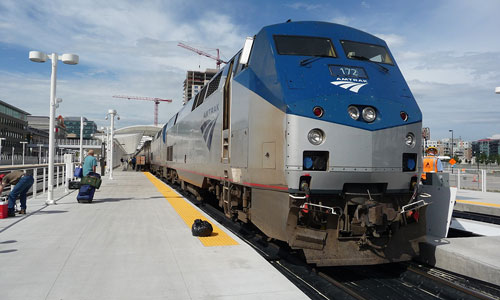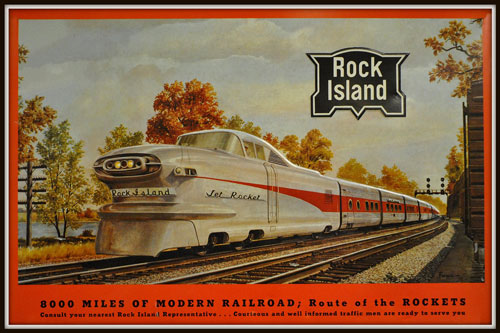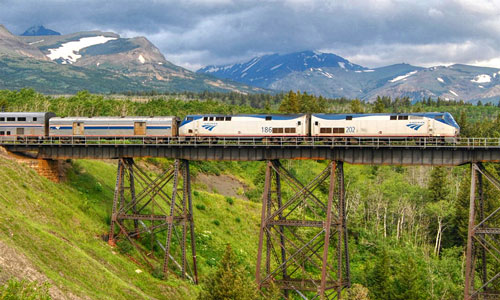Why Are Trains Always Late?
Despite its best efforts, Amtrak always seems like it has hugely delayed arrivals. One possible reason for that? It doesn't own most of the tracks.
Editor’s note: Thanks to Adam Fordham, who wrote me a note a few weeks back during a train delay asking me to write about this topic. Your pain is felt.
“Twenty-five years after I set out to save the American passenger train, I feel personally embarrassed over what I helped to create.”
— Anthony Haswell, a passenger rail advocate, in comments to then-Passenger Train Journal editor Carl Swanson in 1992. Haswell has a reason to feel sore—he spent years trying to sell the federal government on taking over the rail system as the founder of the National Association of Rail Passengers, only to see his work become a shorthand in Washington for out-of-control spending. (Haswell’s comments, for understandable reasons, were prominently included in a 1997 policy paper by Citizens Against Government Waste that spoke of replacing Amtrak entirely.) Recalling the period, he suggests the decision to put passenger rail under federal control was an intentional attempt to encourage its failure. ”There was no question that it would probably not pay for itself," Haswell told the National Journal in 2015. “But the Nixon administration and other conservatives thought that once it was demonstrated that it wouldn’t pay for itself, it would be abolished."

Amtrak owns the trains, but it doesn't own the most of the tracks. (simon1234567/Pixabay)
The structural issues that pain Amtrak have been there since the beginning
As the recent Michael Keaton movie The Founder pointed out, the secret to how McDonald’s makes its money isn’t that it sells burgers.
Instead, the company really makes its money off the real estate which it then leases to franchisees. Ray Kroc was struggling to scrape by despite his growing empire before he figured this distinction out.
Amtrak, love it or hate it, isn’t like that. In fact, it’s literally the opposite of that model: It’s what would happen if the American public went on a diet and McDonald’s suddenly was struggling to the point where the federal government felt compelled to step in. But instead of acquiring the real estate, the government only acquired the restaurants, and let McDonald’s keep the real estate.

A postcard for the Rock Island, a private passenger train provider that predates Amtrak. (Loco Steve/Flickr)
Amtrak, a product of the Rail Passenger Service Act of 1970, came about largely because railroad companies could not make passenger rail profitable anymore. The problem started with cars, but became even worse when planes went mainstream. But while passengers are certainly valuable cargo, rail lines serve up far more valuable cargo on a day-to-day basis, because when it comes down to it, there are a lot of things that are better to ship using rail than by car or plane.
This means a number of things for Amtrak, or as it was called before its initial launch, Railpax. It means that, unlike nearly every other country in the world, the American government largely doesn’t own the intercity rail infrastructure, which limits what the country can do with that infrastructure.
It means that the profit motive for building new tracks that improve the passenger experience on tracks that Amtrak doesn’t own outright is limited. And in most areas of country, it doesn’t own the track—in fact, 97 percent of its route miles are owned by outside companies even to this day.
So why did the government do this again? Simply put, the industry was heading toward a major derailment—specifically in the case of Penn Central. The product of a massive merger between multiple regional railroads, Penn Central filed for bankruptcy slightly more than two years after it first sprung to life—the largest corporate bankruptcy of all time by that point and the very definition of too-big-to-fail. The harsh comedown for Penn Central threatened to hobble rail service, both freight and passenger, on the East Coast, which was then and now the most successful area of the country for when it came to putting people in trains. Penn Central's failure led to the creation of what became Amtrak, and a few years later, Conrail, a federally run freight train-system that managed the remains of Penn Central and other dormant rail lines until someone picked up the mantle.
In the case of Amtrak, to say the least, the move was controversial.
“This is quasi nationalization of the nation’s rail system. It will most likely lead to more government participation as time goes on,” Time correspondent Mark Sullivan said of the move just before President Nixon signed it into law. “The U.S. until now has been the only industrialized country in the world with a totally private rail system. The Penn Central debacle, if not turned around quickly, will hasten the day that this private system becomes another arm of the government."
As it turned out, this fire-and-brimstone scenario, the kind of stuff libertarian thesis papers were designed for, was only half-right.
The U.S. government has a bigger stake in the rail system than it did in 1970, but the railroads are most certainly not an arm of the government.
184
The number of trains that ran on the Amtrak system during its earliest days in 1971—a sharp decrease from the number of lines run by train operators prior to the switch-over, and a point not missed by Congress, where senators complained after entire states were ignored by the revamped model. As Classic Trains magazine notes, some private operators chose to continue their passenger service, but eventually fell into the warm loving arms of public operation.

This Empire Builder train sure looks awesome, doesn't it? Well, it's gonna be late. Sorry in advance. (Locosteve/Flickr)
The challenges passenger rail faces outside the lines
To say the modern-day Amtrak isn’t what it could be is the understatement of the century.
While other parts of the world whiz from city to city in relatively short periods of time, Amtrak barely scrapes by, unable to handle infrastructure upgrades, and hobbled financially by its need to cover both profitable sectors (read: East Coast and anywhere near a big city) and less-profitable sectors (read: everywhere else, especially if there’s dining car service) with a tiny budget, the firm is in a challenging situation.
After 2015’s deadly Amtrak crash in Philadelphia, former Amtrak CEO David Hughes put the problem in stark terms.
“What Amtrak has is among the poorest I’ve ever seen given the level of use they get,” he told CBS News. “The accumulated deferred maintenance and lack of attention really makes it almost a Third World operation.”
And that’s on its own track in its most popular section of the country. At least it generally shows up to Philly or Washington, DC, on time more than 80 percent of the time.
But expand beyond that, and the numbers are often depressing. The Auto Train, a bring-your-vehicle ride between Virginia and Florida, had an on-time performance rate of roughly 35 percent in March. The Empire Builder, which starts in Chicago and makes it way up to the Pacific Northwest, has a rate that’s even worse—it’s on time just 30 percent of the time. There are a lot of factors that go with this, but probably one that matters more than any other is that these lines are some of the many not actually owned by Amtrak.
Why such a stark difference? The easy explanation for this comes back down to the McDonald’s anecdote I pointed out earlier. If you’re a private company that owns a railroad, you want to maximize your investment—and you can do that with freight, which there is more of, which travels more often, and is directly within your control.
If Amtrak was playing poker with the railroad industry and all things were equal, they’d be stuck with all the bad cards.
The Association of American Railroads, which represents freight-line owners, has essentially taken the stance that passenger service shouldn’t matter as much as its bread and butter. From a 2008 policy paper:
Freight railroads recognize the significant potential benefits of a strong national passenger rail system and work to accommodate passenger trains when mutually-beneficial arrangements can be negotiated, as the many successful examples of passenger trains operating on freight-owned property make clear.
However, passenger service must not degrade freight railroads’ ability to serve their freight customers. Freight railroads lower shipping costs by billions of dollars each year and produce an immense competitive advantage for our farmers, manufacturers, and miners in the global marketplace. If passenger railroads impair freight railroads and force freight that otherwise would move by rail onto the highways, those advantages would be squandered. Moreover, highway gridlock would worsen; fuel consumption, pollution, and greenhouse gas emissions would rise; and our mobility would deteriorate—outcomes that are completely contrary to the goals of expanding passenger rail in the first place.
This has proved a surprisingly fraught area in the legal space in recent years, by the way. A 2008 law meant to give Amtrak some leverage in improving on-time performance has proven hugely controversial with freight train companies, and AAR and Amtrak have been fighting the issue in court ever since. (Notably, AAR won a recent round on the issue.)
It’s a complex problem that takes a lot of forms, but it comes down to this simple point: Amtrak thinks that passenger trains should get preference over freight trains. The companies that manage those freight trains feel differently. And there's a lot of competition for these limited resources.
And that’s why, if you take an Amtrak train outside of the Boston/New York/DC area, it’s probably gonna be late.
Fun stuff, eh?
If you’re not a frequent traveler on the East Coast, you may not hear the trials and tribulations of Amtrak on a daily basis, but while you were complaining about United Airlines, Amtrak was in the midst of having a generally horrible month—and nearly all the problems were within its one source of power nationally, the Northeast Corridor.
The tracks around New York City’s Penn Station have suffered from multiple train derailments in the span of a few days, causing major problems for people simply looking to get home. Penn Station is not a place people like to hang out for longer than they need to, so the fact that it happened more than once in the span of a few days was particularly maddening.
And on Tuesday, it was horrible on both ends of the commute. In the morning, a stalled Amtrak train caused massive delays for NJ Transit travelers. And in the evening, an electrical outage forced local commuters into a nightmare scenario where the station was so crowded an entrance had to be closed.
And, remember, this is the part of the track Amtrak owns.
The solution that Amtrak is proposing to these repeated headaches is painful and will cost a lot of money—and is generally due to the poor conditions of the station’s infrastructure.
“My conclusion is that what we really need to do down there is just bite the bullet and start a much more significant renewal program,” Amtrak CEO Charles “Wick” Moorman told The New York Times.
United’s problems are of their own making. But compared to Amtrak’s problems, they’re a cakewalk.
:format(jpeg)/2017/04/tedium042517.gif)
/2017/04/tedium042517.gif)

/uploads/ernie_crop.jpg)